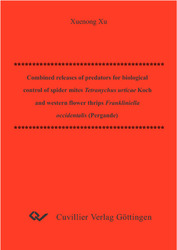| Fachbereiche | |
|---|---|
| Buchreihen (96) |
1378
|
| Nachhaltigkeit |
3
|
| Gesundheitswesen |
1
|
| Geisteswissenschaften |
2365
|
| Naturwissenschaften |
5406
|
| Mathematik | 229 |
| Informatik | 319 |
| Physik | 980 |
| Chemie | 1363 |
| Geowissenschaften | 131 |
| Humanmedizin | 243 |
| Zahn-, Mund- und Kieferheilkunde | 10 |
| Veterinärmedizin | 108 |
| Pharmazie | 147 |
| Biologie | 835 |
| Biochemie, Molekularbiologie, Gentechnologie | 121 |
| Biophysik | 25 |
| Ernährungs- und Haushaltswissenschaften | 45 |
| Land- und Agrarwissenschaften | 1004 |
| Forstwissenschaften | 201 |
| Gartenbauwissenschaft | 20 |
| Umweltforschung, Ökologie und Landespflege | 148 |
| Ingenieurwissenschaften |
1793
|
| Allgemein |
98
|
|
Leitlinien Unfallchirurgie
5. Auflage bestellen |
|
Erweiterte Suche
Combined releases of predators for biological control of spider mites Tetranychus urticae Koch and western flower thrips Frankliniella occidentals (Pergande)
Xuenong Xu (Autor)Vorschau
Inhaltsverzeichnis, Datei (120 KB)
Leseprobe, Datei (120 KB)
Two-spotted spider mite Tetranychus urticae Koch (Acari: Tetranychidae) (TSSM) and western flower thrips Frankliniella occidentalis (Pergande) (Thysanoptera: Thripidae) (WFT) are two notorious pests of ornamental plants and vegetables, both in field and especially in greenhouse cultures. They often occur simultaneously on the same plants. Chemical control is difficult mainly because of problems with low efficiency of insecticides, resistance, residues and interference with biocontrol strategies. The predatory mite Amblyseius cucumeris Oudemans (Acari: Phytoseiidae) and the predatory bug Orius insidiosus Say (Hemiptera: Anthocoridae) are two widely used biological control agents of WFT; both are generalist predators. Besides thrips, spider mites also constitute a main diet of both predators and sometimes Amblyseius and Orius spp. are used to suppress TSSM populations. One aim of this project was to elucidate whether each of the two predators can significantly suppress both pests when occurring simultaneously on the same plant in different densities, and how one of the two pests influences the control efficiencies of the other by both predators. In combined release systems with more than two predators, intraguild predation (IGP) more or less exists, e.g. Orius spp. can also feed on the predatory mite. However, the intensity and consequences of IGPs differ in relation to system parameters like direction of predation (who is predator, who prey) within the predator guild, the density of prey item as well as the availability (density) of and preference for alternative food. Thus, another objective of this project was to evaluate such possible intraguild effects with combined releases of A. cucumeris and O. insidiosus and how they could influence suppression of WFT and TSSM and therefore the efficiency of biocontrol.
| ISBN-13 (Printausgabe) | 3865371973 |
| ISBN-13 (Printausgabe) | 9783865371973 |
| ISBN-13 (E-Book) | 9783736911970 |
| Sprache | Deutsch |
| Seitenanzahl | 290 |
| Auflage | 1 Aufl. |
| Band | 0 |
| Erscheinungsort | Göttingen |
| Promotionsort | Hannover |
| Erscheinungsdatum | 20.09.2004 |
| Allgemeine Einordnung | Dissertation |
| Fachbereiche |
Land- und Agrarwissenschaften
|








